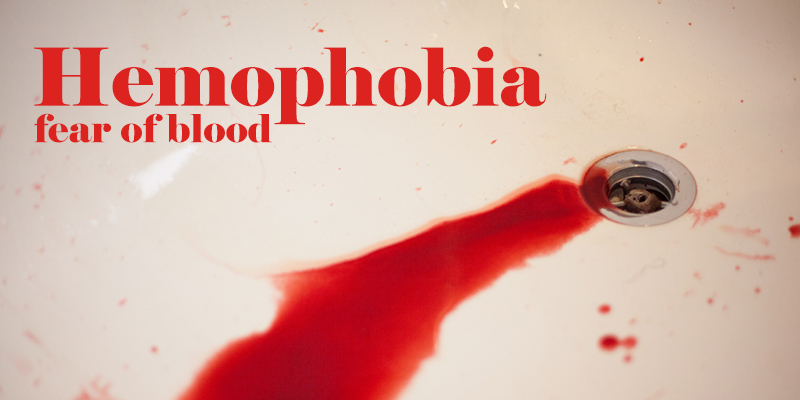Do you feel squeamish when you get a sight of someone bleeding? If that is the case, you are not alone. Thousands of people have the same anxiety and fear triggered by the sight of blood. This is known as hemophobia.
Hemophobia is a word derived from Greek word “haima” which means blood. Hemophobia is signified by extreme fear and nervousness of getting a sight of blood. This may be a bleeding wound, blood of animals or even a thought or picture may develop instant discomfort and anxiety. Most of the times, hemophobia co-occurs with trypanophobia (fear of needles) as people might be scared of any needles due to the fear of bleeding.

How common is Hemophobia?
Hemophobia is also one of the highest occurring phobias in people. At least 2 to 3 percent of the people suffer from hemophobia. This is common both in children and adults, and can occur in both the genders.
What Causes Hemophobia?
Different causes known to develop hemophobia are:
A traumatic Experience
Hemophobia can be caused by a previous traumatic experience associated with blood . It can be an accident or injury or painful medical procedure involving blood. A sight of bleeding can cause a person to worry about their health and well-being, and may lead to hemophobia. It can also occur by witnessing someone else having wound and cuts with bleeding. A lot of coverage of bloodshed in TV and internet may also cause people to feel anxious of blood.
Genetic factors
Hemophobia may also as inherited form of fear. It has been seen that people are more vulnerable to homophobia if they had a previous family history of hemophobia.
Other Phobias
Several other phobias have seen to cause homophobia in people. Homophobia is extensively related with trypanophobia (fear of needles), thanatophobia (fear of death), mysophobia ( fear of germs) and nosophobia ( fear of having a specific illness).
Symptoms of Hemophobia
Common symptoms that signify the occurrence of hemophobia are:
- Extreme fear and nervousness onset by the sight of bleeding ( even a thought or picture can trigger the fear)
- Immediate drop in the heartbeat and blood pressure causing dizziness and fainting
- Complete avoidance of situations involving blood like medical procedures or visiting hospitals
- Panic attacks accompanied by sweating and shaking, numbness around limbs, feeling perplexed, abdominal uneasiness, diarrhea, frequent urination, nausea and vomiting
When to see a doctor?
Hemophobia can be a serious problem if not treated. Fortunately, one may not have to see blood every day. However, if the symptoms have been severe and lasting for more than six months, you need to consult with a doctor. Moreover, treatment is essential if the phobia has been causing a visible disturbance in daily life involving medical routines and hospital visits.
How is it treated?
A combination of therapies and medicines can be used to treat hemophobia.
Cognitive Behavioral therapy (CBT)
CBT is aimed at digging out the negative thoughts associated with blood. The therapist studies the underlying cause for the fear of blood which may be medical routines, injuries or other health ailments. CBT is focused on replacing the doubtful and negative thoughts of the person associated with the blood and wounds. A person can develop tolerable feelings eventually after regular counseling sessions.
Exposure Therapy
Another therapy that goes alongside CBT is exposure therapy. The person is exposed to any object or activity where blood or resembling substance is involved. The therapist tries to reduce the level of fear little by little through regular exposures. The major aim is to instill toleration for blood in the person through such confrontations.
While exposure therapy runs, the therapist also teaches various relaxation methods such as controlling the breathing, mental visualization exercise and squeezing muscles to prevent any fainting and dizziness from occurring.
Medicines
In severe cases, medicines may also be used for getting the symptoms in control. Commonly used medicines are anti-anxiety and anti-depressant medicines for controlling the fearful and distressful feelings.